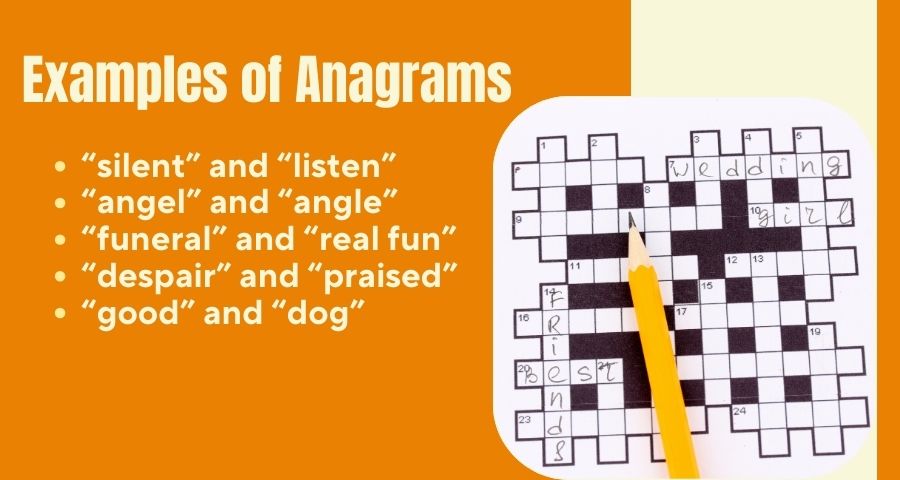Anagrams are word puzzles where the letters of a word or phrase are rearranged to form a new word or phrase, using all the original letters exactly once. It’s like a playful game of rearranging the building blocks of language to create something new and often unexpected.
Anagrams offer a fun way to explore language and exercise creativity by manipulating its fundamental elements and letters.
Examples of Anagrams
Here are some of the best examples of analog computers with facts:
1. Listen – Silent:
These two words are anagrams of each other, showcasing how rearranging the letters can result in a completely different word with an opposite meaning. “Listen” implies actively hearing, while “silent” denotes the absence of sound.
2. Dormitory – Dirty Room:
The transformation of “dormitory” into “dirty room” exemplifies how anagrams can inject humor and creativity into language. This example highlights the whimsical nature of rearranging letters to form new words or phrases.
3. Astronomer – Moon Starer:
Anagrams can unveil hidden meanings or associations, as demonstrated by the transformation of “astronomer” into “moon starer.” This example evokes imagery of someone gazing at the moon, showcasing the imaginative power of linguistic manipulation.
4. Debit Card – Bad Credit:
The anagram “debit card” morphing into “bad credit” humorously illustrates the financial consequences of mismanaging one’s finances. This example cleverly plays on the association between debit cards and financial responsibility.
5. Eleven plus two – Twelve plus one:
This anagram showcases the mathematical curiosity of rearranging numbers to form equivalent but distinct equations. “Eleven plus two” becomes “twelve plus one,” highlighting the symmetrical nature of arithmetic expressions.
6. The eyes – They see:
Anagrams can convey philosophical insights, as seen in the transformation of “the eyes” into “they see.” This example prompts reflection on the nature of perception and the role of the senses in shaping our understanding of the world.
7. Tea – Eat:
Simple yet delightful, the anagram pairing “tea” and “eat” demonstrates how rearranging letters can create words with related meanings. This example underscores the playful versatility of language.
8. Debit card – Did act, bro:
Anagrams can be playful and inventive, as evidenced by the transformation of “debit card” into the cheeky phrase “did act, bro.” This example showcases the whimsical possibilities of rearranging letters to create unexpected phrases.
9. Clint Eastwood – Old West Action:
Names can undergo remarkable transformations through anagrams, as demonstrated by “Clint Eastwood” becoming “Old West Action.” This example highlights the playful reinterpretation of familiar names and phrases.
10. Conversation – Voices Rant On:
Anagrams can encapsulate the essence of a concept or activity, as shown in the transformation of “conversation” into “voices rant on.” This example vividly portrays the dynamic and sometimes chaotic nature of communication.
11. Funeral – Real Fun:
The anagram pairing “funeral” and “real fun” juxtaposes contrasting emotions or experiences, offering a playful twist on the solemnity of funerals. This example showcases the unexpected humor that can arise from linguistic manipulation.
12. Schoolmaster – The Classroom:
Anagrams can evoke specific settings or environments, as demonstrated by “schoolmaster” transforming into “the classroom.” This example conjures images of an authoritative figure in an educational setting, highlighting the evocative power of anagrams.
13. Mother-in-law – Woman Hitler:
Anagrams can yield surprising and even controversial results, as seen in the transformation of “mother-in-law” into “woman Hitler.” This example underscores the unpredictable nature of linguistic manipulation and the potential for unintended interpretations.
14. Desperation – A Rope Ends It:
Anagrams can convey poignant messages or insights, as shown in the transformation of “desperation” into “a rope ends it.” This example offers a thought-provoking reflection on the consequences of despair.
15. Elvis – Lives:
Anagrams can be used to express sentiments or beliefs, as seen in “Elvis” transforming into “lives.” This example pays homage to the enduring legacy of the iconic musician, Elvis Presley.
16. Listen – Silent:
The repetition of “listen” and “silent” underscores the simplicity and elegance of certain anagrams, where rearranging letters creates words with related meanings. This example highlights the poetic symmetry of linguistic manipulation.
17. Triangle – Integral:
Anagrams can reveal unexpected connections between seemingly unrelated words, as demonstrated by “triangle” transforming into “integral.” This example showcases the surprising overlap between geometric shapes and mathematical concepts.
18. The Morse Code – Here Come Dots:
Anagrams can provide clever interpretations of familiar phrases, as seen in “the Morse code” becoming “here come dots.” This example playfully reimagines a well-known communication method, showcasing the creative potential of linguistic manipulation.
19. Schoolmaster – The Classroom:
This repetition serves as a reminder of how anagrams can encapsulate the essence of a word or phrase succinctly and memorably. “Schoolmaster” transforming into “the classroom” vividly evokes images of educational settings and authority figures.
20. Listen – Silent:
We conclude with another example of a simple yet profound anagram, underscoring the beauty and versatility of this linguistic phenomenon. “Listen” becoming “silent” exemplifies the transformative power of rearranging letters to create new meanings.

